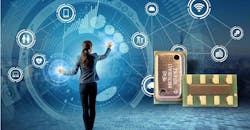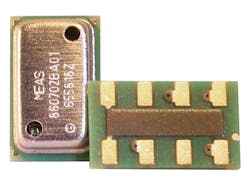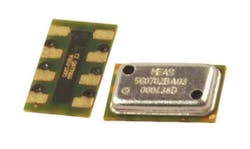Download this article in PDF format.
The general function of the Internet of Things (IoT) is to monitor and control “things” via the internet or some private wireless network. The monitor function clearly dominates, with sensors generating most of the data traffic.
Without good sensors, most IoT applications would not exist. That fact alone makes sensors the critical design component when developing most new IoT applications. Attention to sensor qualities and specifications should be a first consideration when designing nodes for data collection.
Sponsored Resources:
- TE Sensors makes your connected home smarter
- Sensors for Drone Applications
- Sensors for HVACR Applications
Types of Sensors
Literally dozens, if not hundreds, of different sensors exist, and you probably know most of them. Temperature is the most often sensed characteristic, and not surprisingly, multiple sensor types are available, such a RTD, thermistor, thermocouple, solid state, and others.
Other measurable physical characteristics include pressure, humidity, moisture, flow, and wind speed. There are proximity sensors, rotary position sensors, and limit switches. Microphone sound sensors are common. And then there are sensors for ultrasonics, liquid level, rotary speed (rpm), torque, and vibration.
One special category is light sensors. Visible light and infrared (IR) light sensors are most often employed. Video camera sensors represent more complex sensor types but widely used. LiDAR sensors developed for self-driving cars are also sophisticated types.
Other special sensors include accelerometers, gyroscopes, and magnetometers. Gas and smoke detectors are also in the mix. Whatever physical characteristic you need to measure, you will find an appropriate sensor.
Sensor Interfacing
Many sensors, if not nearly all, are analog types that produce a continuously variable output in proportion to the physical characteristic being sensed. Furthermore, that output is often very small and subject to noise. Since most IoT nodes transmit digital data only, these analog sensor outputs must be digitized. As a result, some signal conditioning is needed to make the outputs suitable for use.
Signal conditioning may include amplification and noise filtering as required. Analog outputs are sent to analog-to-digital converters (ADCs) to be digitized. From there, these appropriately conditioned signals are sent by some serial data interface to the radio for transmission. Common serial interfaces include UART, I2C, and SPI.
Many if not most commercial sensors include a microcontroller (MCU) that typically has an on-board ADC, all of the necessary serial interfaces, plus any signal conditioning. In many cases, they’re ready to use.
Sensor Specifications
Below are the primary features you should look for when seeking out a sensor for your application:
Range: This is the scope of the characteristic to be measured. Will the sensor handle the maximum and minimum measurements needed for your application?
Resolution: This applies to the digital output. It usually determines the minimum measurement unit. It’s a measure of measurement precision. Resolution is expressed in the number of data bits derived from the ADC that are to be transmitted.
Accuracy: A measure of the measurement’s “trueness.” The opposite of % error. Usually expressed as a percentage: Accuracy = 100% − Error
Temperature: The operational temperature range in the target environment.
I/O: This is the digital serial interface type—I2C, UART, or SPI.
Power consumption: Critical for battery-powered sensor nodes. Expressed in milliwatts.
Supply voltage range: Usually in the 1.5- to 3.6-V range, but could be 5 V.
Packaging: Size and housing type. Some IC packaging formats.
Examples of Sensor Products
The two scenarios below show the range of a typical sensor. One centers around home/consumer products and the other is for an interesting application—drones.
The Connected Home
Many homes today use the IoT to make the house smarter. IoT makes homes safer, more convenient, and more energy-efficient. Security systems use IoT sensor nodes to detect break-ins and presence. Thermostats use temperature sensors to provide an input to the home heating, ventilating and air-conditioning (HVAC) system operation. And many homes have a weather station that monitors indoor and outdoor temperature, humidity, and barometric pressure. Such setups typically require multiple sensors.
1. Only 5 × 3 × 1 mm in size, the MS8607 accurately measures temperature, humidity, and pressure.
One option is a combination sensor that measures all three characteristics, such as TE Connectivity’s MS8607 (Fig. 1). Since it measures pressure, humidity, and temperature, it becomes a good option for a home weather station or some other environmental monitoring application. Its pressure function makes it a candidate for an altimeter implementation in laptops or smartphones.
Typical measurement ranges for the MS8607 are −40 to +85°C for temperature; 300 to 1100 mbar for pressure; and 0 to 100% for humidity. The fully factory-calibrated device comes in a 5- × 3- × 1-mm QFN package and runs from 1.5 to 3.6 V. The interface is I2C.
Drone Applications
From agriculture to military, from retail to real estate, the demand for functionally specific commercial drones is increasing in industries and organizations across the globe. Drones are now highly developed and being increasingly adopted in many fields.
To make these devices safe, effective, and in full compliance with the regulations, they must be fully instrumented so that their altitude, position, speed, and other factors are known. Multiple sensors are needed to measure the surrounding conditions and telemeter the results back to the ground controller. A critical factor is altitude, which requires a pressure sensor.
An example of a barometric pressure sensor is TE Connectivity’s MS5607 (Fig. 2). This digital barometric pressure sensor (MS5607/MS5611) measures air pressure and then converts it into altitude. Drones use air-pressure sensors to stabilize altitude, allowing for the hover capabilities needed for videography or photography. Barometric-pressure sensors along with accelerometers and gyroscopes enable drones to fly with precision.
2. The MS5607 measures barometric pressure and converts it to an altitude reading for use in drones.
This sensor is optimized for altimeters and barometers with an altitude resolution of 10 cm/20 cm. The sensor module includes a high-linearity pressure sensor and an ultra-low-power, 24-bit ΔΣ ADC. SPI and I2C bus interfaces are available to interface with virtually any microcontroller. Packaging for the device, which runs from 1.5 to 3.6 V, is a 5 × 3 × 1 mm QFN.
TE Connectivity offers a huge range of sensors for practically every IoT application. Development boards for most of them are also available, which help make testing and validation faster and easier.
Sponsored Resources:
About the Author

Lou Frenzel
Technical Contributing Editor
Lou Frenzel is a Contributing Technology Editor for Electronic Design Magazine where he writes articles and the blog Communique and other online material on the wireless, networking, and communications sectors. Lou interviews executives and engineers, attends conferences, and researches multiple areas. Lou has been writing in some capacity for ED since 2000.
Lou has 25+ years experience in the electronics industry as an engineer and manager. He has held VP level positions with Heathkit, McGraw Hill, and has 9 years of college teaching experience. Lou holds a bachelor’s degree from the University of Houston and a master’s degree from the University of Maryland. He is author of 28 books on computer and electronic subjects and lives in Bulverde, TX with his wife Joan. His website is www.loufrenzel.com.


